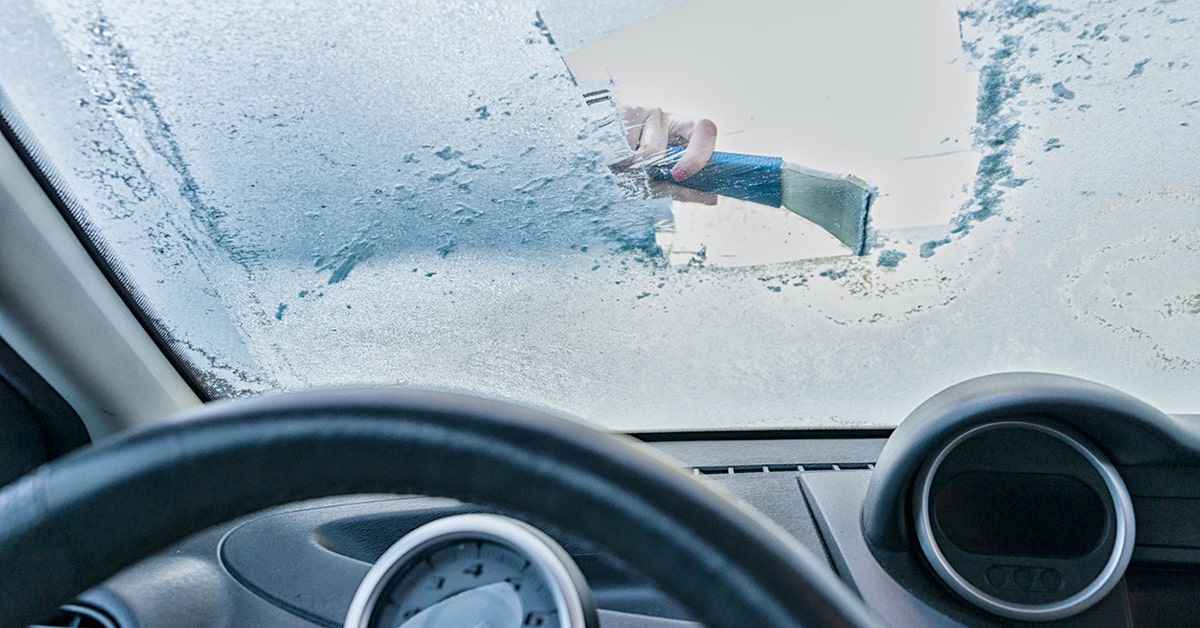The Quickest Way To Defrost Your Car With The Defroster
It’s pretty frustrating when you’re in a hurry but find out after getting into your car that you won’t be able to drive away anytime soon because of fogged up or frosted windshield and windows. This is where the defroster in your car comes into play. A vehicle defroster is handy for getting rid of frost or ice on your windshield on those cold winter days.
Fortunately, if you know how to use the car defroster properly, you can quickly clear up the glass and hit the roads. In this car maintenance tips guide, learn how a car defroster works, including both the front and rear defroster, and a step-by-step guide on how to defrost your windshield and windows on cold days as well as defogging them on rainy days.
How a Car Defroster Works
Hot air holds more moisture in it than cold air, or in other words, at high temperatures, moisture is easily suspended in the warm air. But when the weather is cooler, moisture in the air is no longer suspended but is released and condensed into all those little water droplets that fog up your car’s windshield and windows.
You will see this happens on cold mornings, when the overnight ambient air drops in temperature while the air inside your vehicle is still warmer, even when you parked your car outside overnight. At freezing temperatures in the winter, the condensation turns into frost or ice, which might require some scraping away by hand using an ice scraper on top of some thawing by the defroster.

It’s important to note that your car’s defroster works hand in hand with the air conditioning system to deal with fogging or frosting on the glass. In both the hot or cold settings, your air conditioner condenses the moisture in the air into tiny water droplets. This condensation is vented through a drain hose that runs from behind your glove box and dispensed outside from the bottom of the car. The system then supplies new dry air into the cabin. When you turn on the defroster, it pumps dry air up toward the windshield to quickly evaporate the moisture around this area and effectively defrost the windshield.
What this means is using the defroster together with the A/C is the quickest way to defrost your windshield. But it also means that if your air conditioner isn’t working properly, you won’t be getting optimal performance from your defroster either, and it may only clear the moisture from the glass slightly.
You will learn the proper steps to most effectively defrost or defog your windows and windshield further down below. In general, as above, the defroster is used hand in hand with the A/C for defogging, but you may notice that cold air works better during the summer and warm air works better during the winter, depending on the temperature difference between the outside ambient air and your car’s interior air.
In addition to drying the humidity from the air, your defroster also serves to equalize the temperature of the glass and the temperature of the air inside the vehicle to some extent.
Front Defroster and Rear Defroster: How They Work
The majority of older cars only have the front defrosters on the windshield. This might not be very helpful in terms of visibility if the rest of your windows are all fogged up. Fortunately, many newer models also pack rear defrosters on the rear window as well to quickly restore visibility.
Front defroster
The front defroster works a little differently than the rear units. The front defroster has vents on the dashboard that face the windshield and front windows. When you turn on the front defroster, air will be circulated through these vents and directed toward the windshield and front windows to defrost the windows. This air is circulated thanks to the fan and blower motor that operates the heating and air conditioning system. This is why we said earlier that your defroster is tied into your A/C system.
To engage the front defroster, you just need to turn on the fan and turn the setting to defrost, while making sure the vents are open and then adjust the temperature to your desired level.
When you engage the front defroster, the coolant will reach a certain temperature to open the thermostat. Hot water will move through the heater’s core to heat up the air, then the blower fan will blow the warm air through the vents of the defroster and directly onto the windshield and front windows. The glass will warm up, and as it reaches the desired temperature, the condensation or frost will begin to dissipate.
In addition to removing condensation and ice on the outside of the glass, the front defroster can also remove fog on the inside of the glass. Condensation in the interior often occurs when the air outside is cooler than the air inside.
While the rear defroster will begin removing the condensation immediately upon activation, the front defrost with the fan and blower must wait until the temperature of the vehicle warms up to the desired level for it to defog or defrost effectively.
Rear defroster
For most newer vehicles today, the rear defroster is electric and has its own button for separate access when you want to defrost the rear window. The rear window will have thin black lines running horizontally across it, which are electrical. When the rear defroster is activated, these electrical lines will heat up and thus you will notice the condensation or frost dissipating first along the lines until the entire window is clear.
These heated electrical lines only provide a low amount of heat enough to defrost ice and won’t burn you if you touch the window while they are activated.
One huge advantage of such an electric rear defrost system is that it begins working very quickly as soon as you turn the vehicle on and hit the rear defrost button. That is why many newer vehicles are including electric defroster along the edges of the front windshield on top of the front defroster to remove condensation faster.
Side view mirrors defroster
The side view exterior mirrors also use electrical defrosters like those on the rear windows to remove condensation and frost in the winter for battery visibility, but you won’t see visible thin black lines as with the rear window defroster.
READ MORE
The Quickest Way To Defrost Your Windows and Windshield
- Turn your heater on: As above, warmer air can suspend more moisture. If the air in your car holds a lot of moisture, then it will condense as tiny water droplets on the windows and windshield on cooler days, as the glass surface is colder and thus the air on its surface is colder than the air in the cabin. So the principle for dealing with cabin condensation must start with increasing the temperature inside your car. Start your engine, activate the defroster setting, then crank the heater up all the way and direct warm air at your windshield and front windows to evaporate excess moisture on the glass.
- Press the A/C button: Now after cranking up your heater, turning on the A/C may sound counterintuitive, but really what you’re doing is activating a setting on the air conditioning system that helps dry the interior air faster. You can defrost your car without using the A/C, but using the A/C together with the heater is actually the quickest way to defog and defrost your car effectively. The A/C will pull the moisture from the air as it passes over the cooling coils in your cooling system.
- Turn on air recirculation in the winter: You need a new supply of fresh air to enter the cabin as well. Winter air is cold, which means it does not hold much moisture. Letting this dry air entering your car will help dry the saturated air inside more quickly.
- Crack your windows just a little bit: Again, this helps the dryer outside air to enter and replace the humid air in your car, speeding up the defogging process.
- Defrost windows with homemade de-icing solution: After you’ve performed the above steps to defog our windows, if there’s ice buildup on the exterior of the glass, you’ll need to defrost from the outside while the defroster and A/C is working. Contrary to what many folks expect, de-icing your windows never requires and should never involve hot or boiling water. You can use a plastic scraper with a brush at one end to remove the ice, but this can take forever.
For easy defrosting, mix a homemade de-icing solution of 2/3 cup Isopropyl or rubbing alcohol and 1/3 cup water and pour the mixture into a spray bottle. This solution will not freeze, since rubbing alcohol has a freezing point of 138 degrees below zero, and will allow you to easily spray away windshield ice. This also means that you can store this spray bottle in your car at all times during the winter for use.
To defog your windows and windshield when it’s not freezing but raining though, you won’t be able to crack the windows open. In this case, do this for quick defogging:
- Turn on your A/C: Turn on the A/C for the cooling coils to remove moisture from the cabin air.
- Turn off air recirculation: This is the number one mistake people make when trying to rapidly defog windows. When it’s raining, the air outside will have a lot of moisture, so you won’t want it to enter the cabin.
Common Reasons Your Defroster Is Not Working
If you find that your defroster is not working properly as per usual, inspect for the following issues and have them fixed:
- Lack of antifreeze: When there’s not enough antifreeze, the heater will not heat up properly and thus the defroster won’t be as effective in defrosting the windows.
- Clogged defroster vent: When the front defroster’s vent is clogged with dust and debris, the warm air cannot blow through to heat up the windshield and front windows. A dirty vent will need to be cleaned.
- Frayed wires: Wires that are loose or frayed will prevent the defroster from working and needs to be secured or replaced.
- Blown fuse: An overloaded circuit might blow the fuse that connects to the defroster. The fuse will need to be tested and replaced by a professional.
- Stuck or malfunctioning buttons or knobs: A stuck button might be repaired, but if it malfunctions, it may need replacement.
- Missing terminal edges on the window: Tinted windows that have started cracking or tint that has come off can render the defrosting process less effective.














